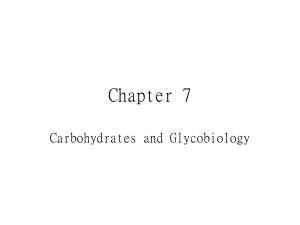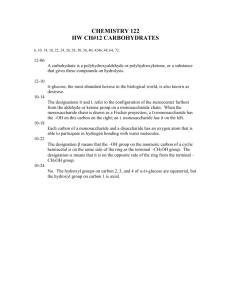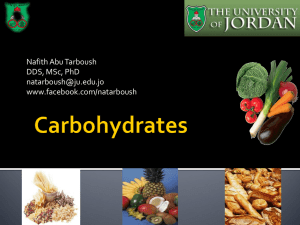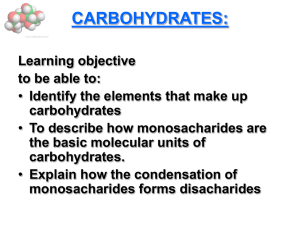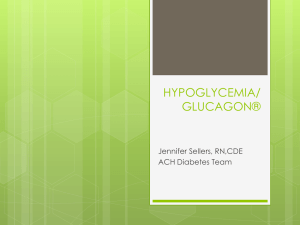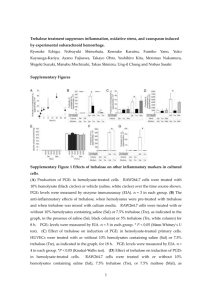Document
advertisement
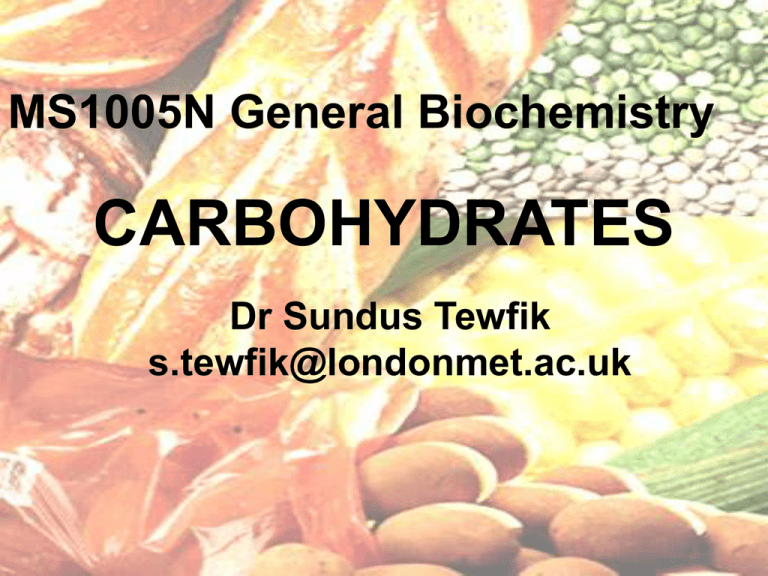
MS1005N General Biochemistry CARBOHYDRATES Dr Sundus Tewfik s.tewfik@londonmet.ac.uk Learning outcomes: To know some of the roles of carbohydrates in biology. To relate this to their structures and basic chemistry. To know the structures and names of some common carbohydrates. CARBOHYDRATES 1. Carbohydrates (CHOs) are ketone or aldehyde compounds with multiple hydroxyl groups 2. They serve as a) energy stores, fuels and metabolic intermediates. b) part of the structural framework of DNA and RNA. c) structural elements in the cell walls of bacteria and plants and exoskeleton of invertebrates. and they are linked to many proteins and lipids. Some Carbohydrate Functions • Developmental processes • Protein localization • Regulation of activity • Cell-cell interactions • Structural integrity, e.g. cell walls • Phytohormones • Plant and animal defence • Prevention of desiccation (bacteria) • Adherence of bacteria to surfaces • Bacterial resistance to host defences • Cell-cell recognition and signalling Monosaccharides 3. simplest CHOs are aldehydes or ketones that have 2 or more hydroxyl groups. I CHO CHO empirical formula : H C (CH 2O)n or H - C - OH HO C H I OH CH2OH CH2OH CHO CHO the smallest ones (where n=3) are glyceraldehyde and D-glyceraldehyde L-glyceraldehyde dihydroxyacetone H C OH HO CH2OH C H CH2OH D-glyceraldehyde L-glyceraldehyde dihydroxyacetone aldoses a ketose 4. Glyceraldehyde has an asymmetric carbon atom, therefore it has 2 stereoisomers the D and L forms (these are enantiomers ie mirror images, not superimposable). Asymmetric carbon; four different things are attached to it Stereoisomers have The same chemical formula The same order and types of bonds Different spatial arrangements Different properties 5. Based on number of carbons, a monosaccharide is a Number of carbon atoms 4 5 6 7 Name of sugar tetrose pentose hexose heptose 6. 2 common hexoses are D-glucose (an aldose) and D-fructose (a ketose) Aldoses have an aldehyde group at one end. H Ketoses have a keto group usually at C2. O CH2OH C H C OH HO C H H C OH H C OH CH2OH D-glucose Tautomers C6H12O6 C O HO C H H C OH H C OH each have the same formulae CH2OH D-fructose Fig. Mathews, van Holde, and Ahern Biochemistry 3rd edition. Aldoses Fig. Mathews, van Holde, and Ahern Biochemistry 3rd edition. Ketoses 7. D and L refer to the configuration at the asymmetric carbon atom furthest from the aldehyde or keto group H O D because of configuration at asymmetric carbon atom furthest from C H C OH HO C H H C OH H C OH CH2OH D-glucose O H C H – C – OH HO – C – H H – C – OH H – C – OH CH2OH D-glucose O H C HO – C – H H – C – OH HO – C – H HO – C – H CH2OH L-glucose Most naturally occurring sugars are D isomers. 8. A molecule with n chiral carbon atoms (asymmetric centers) has 2n stereoisomeric forms. 9. Possible to draw up 2 series of D-sugars - the D-aldoses and the D-ketoses. Note that the chiral C furthest from -CHO always has -OH to right therefore D series of sugars Important sugars are ribose, glucose, mannose, galactose, xylose. Glucose, mannose, galactose are the most abundant. D-sugars differing at a single asymmetric centre are called epimers. glucose/mannose are epimers at C2 glucose/galactose are epimers at C4 10. Fewer D-ketoses since D-erythrulose only has 1 asymmetric centre (dihydroxyacetone is not optically active). D-fructose is the most abundant ketohexose. D-erythrulose 11. In solution, glucose and fructose are not mainly open chains. They cyclise into rings (as follows) 12. An aldehyde can react with an alcohol to form a hemiacetal H C H O + R' OH R aldehyde R' O C R alcohol hemiacetal OH 13. In glucose (open-chain) the C-1 aldehyde reacts with the C-5 hydroxyl group intramolecular hemiacetal The linear aldehyde is tipped on its side, and rotation about the C4-C5 bond brings the C5-hydroxyl function close to the aldehyde carbon. For ease of viewing, the six-membered hemiacetal structure is drawn as a flat hexagon, but it actually assumes a chair conformation. The hemiacetal carbon atom (C-1) becomes a new stereogenic center, commonly referred to as the anomeric carbon, and the α and β-isomers are called anomers. The six membered ring is called pyranose - similar to pyran. H C H O + R' OH R' O R C OH R aldehyde alcohol hemiacetal 14. Similarly a ketone can react with an alcohol hemiketal R C R O + "R OH R' ketone "R O C R' alcohol hemiketal OH 15. The C-2 keto group in open chain fructose can react with the C-5 hydroxyl group intramolecular hemiketal. The five membered ring is called furanose -similar to 16. Ring forms are called Haworth projections (straight chains are Fischer projections). 17. There is an additional asymmetric centre created on cyclisation at C-1 with aldose sugars eg with glucose either α or β possible (OH below ring -α, OH above ring β ). The forms are anomers of each other. 6 CH2OH 6 CH2OH 5 H 4 OH O H OH 3 H H 2 OH -D-glucose H 1 OH 5 H 4 OH H OH 3 H O OH H 1 2 OH -D-glucose H 18. Fructose can also have α or β forms, here the OH group is attached to C-2 (which is anomeric). D- fructose α-D- Fructofuranose β-D- Fructofuranose 19. Fructose also forms pyranose rings. This form predominates in fructose but furanose is the main form in derivatives. α-D- Fructopyranose β-D- Fructopyranose 20. 5 carbon sugars such as D-ribose and D-deoxyribose form furanose rings. 21. In water, α- D- glucopyranose and β- D- glucopyranose interconvert through the open chain form of the sugar. 22. The specific rotations of the α and β anomers of glucose are +112 and +18.7. When a crystalline sample of either anomer is dissolved in water the specific rotation changes over time until +52.7is reached. Initial state 1 Aqueous solution of D-glucose with X g/ml and a specific rotation of +112.2° Final state for both Equilibrium solution with a specific rotation of +52.7° Initial state 2 Aqueous solution of D-glucose with X g/ml and a specific rotation of +18.7° This change is called mutarotation and results from an equilibrium mixture of 1/3 α and 2/3 β anomers. Note: very little (<1%) open chain is present 23. Fructose also shows mutarotation. 24. The open chain form of aldose or ketose is the reducing agent in tests for reducing sugars. This is because the aldehyde group that is present can be oxidized to form a carboxylic acid group, or in the presence of a base, a carboxylate ion group. Common test reagents are : Benedicts reagent (CuSO4 / citrate) Fehlings reagent (CuSO4 / tartrate) They are classified as reducing sugars since they reduce the Cu2+ to Cu+ which forms as a red precipitate, copper (I) oxide. red precipitate D-glucose 25. Conformation of pyranose or furanose rings: The 6-membered pyranose ring cannot be planar because of the geometry of its saturated carbon atoms. They adopt chair or boat conformations Substituents to the ring are of 2 types, axial (a) or equatorial (e). Axial bonds are nearly perpendicular to the plane of the ring () to the plane of the ring, equatorial bonds are nearly parallel () to the plane of the ring to plane. Sugar derivatives H C OH HO C H OH H C OH OH H C OH H C OH H C OH H C OH HO C H H C OH H C CH2OH H C D-ribitol CHO COOH CH2OH CH2OH D-gluconic acid COOH D-glucuronic acid sugar alcohol - lacks an aldehyde or ketone; e.g., ribitol. sugar acid - the aldehyde at C1, or OH at C6, is oxidized to a carboxylic acid; e.g., gluconic acid, glucuronic acid. Sugar derivatives CH CH22OH OH CH CH22OH OH OO HH HH OH OH HH HH OH OH HH OH OH OH OH HH OO HH NH NH22 HH HH OH OO OH OH OH HH NN CC CH CH33 HH -DD-glucosamine -glucosamine -DD-N-acetylglucosamine -N-acetylglucosamine amino sugar - an amino group substitutes for a hydroxyl. An example is glucosamine. The amino group may be acetylated, as in N-acetylglucosamine. Glycosidic bond The anomeric hydroxyl and a hydroxyl of another sugar or some other compound can join together, splitting out water to form a glycosidic bond: R-OH + HO-R' R-O-R' + H2O 26. If glucose is warmed in anhydrous methanol containing HCl, the anomeric carbon atom reacts with the methanol to form α methyl glucoside and β methyl glucoside 27. Each single Haworth structure is a monosaccharide. These can be linked together by O-glycosidic bonds disaccharides polysaccharides. For example, in cellulose, D-glucose residues are joined by glycosidic linkages between C-1 of one glucose and the hydroxyl oxygen atom of C-4 of another glucose. These glycosidic bonds have a β configuration 28. Three highly abundant disaccharides are maltose, lactose and sucrose Disaccharides Maltose Glc(14)Glc reducing maltase Plants (starch) Animals (glycogen) Cellobiose Glc(14)Glc reducing cellulase Plants (cellulose dimer) Lactose Gal (14)Glc reducing Lactase Milk (major energy source) Sucrose Glc(12)Fru nonreducing Sucrase (invertase) Fruits seeds roots and honey 29. Sucrose obtained commercially from sugar cane or sugar beet It is .unusual in that the anomeric carbon atoms of glucose and fructose are involved in the glycosidic linkage. This means no aldehydes are free therefore no reducing groups therefore sucrose is non-reducing sugar. The hydrolysis of sucrose to glucose and fructose is catalysed by invertase (also called sucrase). This hydrolysis from sucrose (value for the optical rotation)[α]D20 = +66.5 to D-glucose [α]D20 = +52.5 and D-fructose [α]D20 = -92 is called inversion (because the net change is from dextro to laevo). The final mixture of glucose and fructose is called invert sugar. Trehalose is another example of a non-reducing disaccharide. Optical activity of sugars and L- define the positions of the atoms in space relative to reference compound and not the optical rotation Ability to rotate plane polarized light (designated d and l or + and -) dextrorotatory rotate to right use (+) symbol usually D isomers D- Laevorotatory rotate to left use (-) symbol usually L isomers Light is passed through a polarized filter. A solution of an optical isomer will rotate the light one direction 30. Lactose (the main sugar in milk) consists of galactose joined to glucose by a β 1,4 glycosidic linkage. It is hydrolysed to these monosaccharides by βgalactosidase in bacteria and lactase in humans. 31. Lactase deficiency: In certain populations adults are deficient in lactase. For these adults when milk is ingested, lactose is not broken down and accumulates in the small intestine. This has an osmotic effect drawing fluid from the cells into the small intestine therefore lactose causes distention, nausea, cramping pain and watery diarrhoea. Note: 3% incidence among Danes but 97% incidence among Thais. Trehalose Trehalose is a disaccharide composed of two glucose molecules bound by an alpha, alpha-1,1 linkage. Since the reducing end of a glucosyl residue is connected with the other, trehalose has no reducing power. α, 1 1 glucosyl glucopyranose Trehalose is widely distributed in nature. It is known to be one of the sources of energy in most living organisms and can be found in many organisms, including bacteria, fungi, insects, plants, and invertebrates. Mushrooms contain up to 10-25 % trehalose by dry weight. Furthermore, trehalose protects organisms against various stresses, such as dryness, freezing, and osmopressure. In the case of resurrection plants, which can Jive in a dry state, when the water dries up, the plants dry up too. However, they can successfully revive when placed in water. Empirical evidence shows that high concentrations of trehalose in the tissues of certain insects and desert plants allows them to survive in a state of suspended animation under conditions of water deficiency. Trehalose helps frogs to survive in a frozen state and also helps to revive the DNA of salmon sperms from dehydration. Its relative sweetness is 45% of sucrose. Trehalose has high thermostability and a wide pH-stability range. Therefore, it is one of the most stable saccharides. In trehalose, one glucose molecule is upside-down relative to the other. In maltose, the two glucose molecules are in the same orientation. This small difference reflects in the properties of trehalose. It does not brown when heated; it does not promote bacterial growth or tooth decay as much as maltose or sugar, and it is less attractive to moisture. Trehalose creates a more crystalline formation with neighbouring water molecules than that created between water molecules and the two similar disaccharides. Trehalose modifies the structural and dynamic properties of water, forming a unique entity with water molecules which makes it better able to protect biological structures The term "trehalose" was coined when the same substance was identified as a component of the secretions of a beetle in the Iraqi desert. These secretions, known by native peoples to be edible and sweet, were called the "trehala manna. " Some people believe that this is a similar substance to the manna that was gathered and eaten by the Israelites of the Old Testament There is a variety of manna obtained from the nests and cocoons of a Syrian coleopterous insect (Larinus maculatus, L. nidificans, etc.) which feeds on the foliage of a variety of thistle. It is used as an article of food, and is called also nest sugar Larinus maculatus The Bedouin gather this sweet product from leaves of trees and bushes, and use it as a sugar substitute in coffee. The sugar fraction was found to consist mainly of trehalose. Two samples contained 30% and 45% of trehalose, respectively, calculated on the basis of total dry matter, and 70% and 80%, respectively, calculated on the total carbohydrate content. Features attracts pharmaceutical industry Low reactivity Stability with basic drug Non-hygroscopicity High compactibility Heat and pH stability Taste and odor-masking effect
